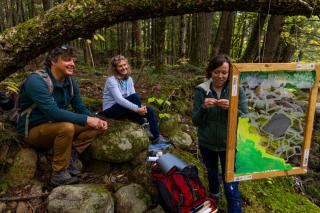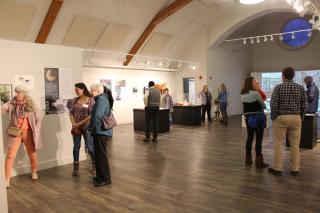Hubbard Brook’s Art-Science program celebrates 10 years
NEW HAMPSHIRE—Since 2013, Northern Research Station’s Hubbard Brook Experimental Forest has been fostering the relationship between artists and scientists through the Art-Science program. It provides an opportunity for artists and scientists to come together in authentic working relationships to better understand northern forest ecosystems and to share that knowledge with a broad audience. The program is built on the premise that human societies in the 21st century are facing increasingly complex and inter-related social and ecological problems, like climate change, that require interdisciplinary cooperation. And it’s working!
Some of the results were on display from November 2022 through February 2023 at Plymouth State University’s Museum of the White Mountains. The exhibit, “Field Station: Art-Science in the White Mountains,” brought together works by many of the artists that have residencies at Hubbard Brook (past and current). The art ranged from traditional paintings to interactive audio/visual pieces of water flow through a forest.
Both scientists and artists agree that coming together to collaborate and create is mutually beneficial.
“I’ve found that I can better do my science by working with artists, recognizing that artists have a different lens and a different way of looking at things,” said Lindsey Rustad, a researcher at the Northern Research Station in Durham, New Hampshire.

Rustad has spent decades studying northern forest ecosystems at the Hubbard Brook Experimental Forest while also championing the Art-Science program and its growth. She’s worked closely with several artists in residence, including Marty Quinn, a composer and computer scientist, who creates animated art among other things. In looking at patterns in different data, Quinn coded wind direction data at Hubbard Book. The colors went from dark blue to white to dark blue to white—just a regular pattern. He came to Rustad and asked about the pattern. In reviewing the data together, they recognized that it was mountain-valley breezes, called Katabatic winds, that flow through the central valley of the 8,700-acre experimental forest.
And that’s just one example. All the collaborating artists have web features that explore the projects they are working on: Rebecca Shultz, Marty Quinn, Xavier Cortada, Nikki Lindt, Rita Leduc, Rich Blundell, Raisa Kochmaruk and Torrin Hallett.
A few of the scientists involved with this innovative work are in the middle of writing a peer-reviewed article on the convergence of science and art at long-term ecological research stations such as Hubbard Brook. Others are working on developing curricula integrating science, art and music to teach middle school students about water and climate, based on the Hubbard Brook WaterViz. These lessons will also be featured at a summer teen camp for students with visual impairments, sponsored by the South Carolina Commission for the Blind.
After 10 years, Rustad and others are exploring what’s next for the exciting program, which includes expanding the program into schools—exploring climate science, art and music. At the intersection of art and science is wonder and that’s a worthy investment!

